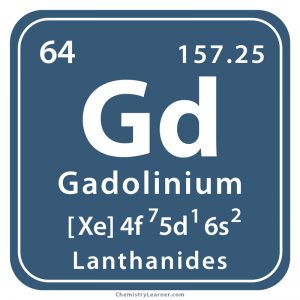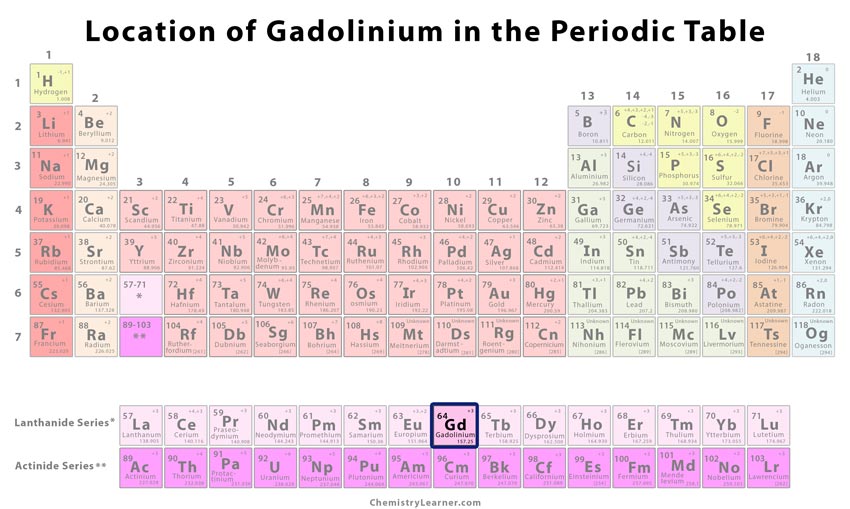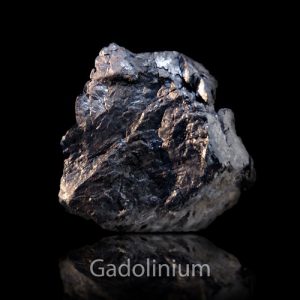Gadolinium
What is Gadolinium
Gadolinium (pronounced as GAD-oh-LIN-ee-em) is a soft metal belonging to the family of rare earth metals [1]. Denoted by the chemical symbol Gd, it has seven naturally-occurring isotopes of which Gadolinium-160 has the longest half-life [1].
Where is Gadolinium Found
Trace amounts of the element are present in monazite and bastnaesite minerals with an abundance of 6.2 mg/kg in the earth’s crust. It is commercially produced through ion exchange and solvent extraction using those minerals, and also by reducing anhydrous gadolinium fluoride with calcium [1].
History
Origin of its Name: It is named after the Finnish chemist and physicist Johan Gadolin.
Who Discovered Gadolinium: Jean Charles Galissard de Marignac was the discoverer of the element.
When and How was it Discovered
According to Marignac, he was sure about the existence of another element in the didymium mixture found by Carl Mosander, the Swedish chemist. When scientists Marc Delafontaine and Paul-Emile Lecoq de Boisbaudran at Paris analyzed the mixture, they found spectral lines that did not match with the source. In 1880, Marignac successfully isolated the new element from it followed by Boisbaudran in 1886 who named it gadolinium [1].
Gadolinium Identification |
|||
| Atomic number | 64 [1] | ||
| CAS number | 7440-54-2 [1] | ||
| Position in the periodic table [1] | Group | Period | Block |
| Lanthanides | 6 | f | |
Properties and Characteristics of Gadolinium
General Properties |
||
| Relative atomic mass | 157.25 [1] | |
| Atomic mass | 157.25 atomic mass units [3] | |
Physical Properties |
||
| Color/appearance | Silver [1] | |
| Melting point/freezing point | 1313°C (2395°F) [1] | |
| Boiling point | 3273°C, 5923°C [1] | |
| Density | 7.90 g cm-3 [1] | |
| State at normal room temperature (solid/liquid/gas) | Solid [1] | |
Chemical Properties |
||
| Oxidation state/Oxidation number | +1, +2, +3 [1] | |
Atomic Data of Gadolinium (Element 64)
| Valence electrons | 3 [5] | ||||||
| Electron configuration (noble gas configuration) | [Xe] 4f75d16s2[1] | ||||||
| Atomic structure [6] | |||||||
| – Number of Electrons | 64 | ||||||
| – Number of Neutrons | 93 | ||||||
| – Number of Protons | 64 | ||||||
| Radius of atom | |||||||
| – Atomic Radius | 2.34 Å [1] | ||||||
| – Covalent Radius | 1.82 Å [1] | ||||||
| Ionization energy [1]
(kJmol-1) |
1st | 2nd | 3rd | 4th | 5th | 6th | 7th |
| 593.366 | 1166.51 | 1990.49 | 4245 | – | – | – | |
What is Gadolinium Used for
- Iron and chromium alloys containing up to 1% of gadolinium have a greater resistance against oxidation and high temperature. Gd is also added to alloys used in magnets, storage disks, and electronic components [1].
- The ability of the element to capture neutrons makes it useful in control rods of nuclear reactors [1, 2].
- Gadolinium is combined with yttrium to make garnets that have microwave applications [4].
- Gadolinium-based agents are used in MRI and CT scan procedures even though the element does not exhibit any radioactivity [8].
Toxicity and Dangers of Using Gadolinium
There is no information about any adverse risks on humans upon its exposure. However, in some instances, Gd-based MRI contrast agent has seemed to cause mild side effects like allergic reactions, nausea, and vomiting [3].
Interesting Facts
- Since gadolinium has magnetic properties, its temperature increases under the influence of magnetic field and decreases when withdrawn [7].
Gadolinium Price
The cost of the element may vary between $450 and $500 per 100 grams.
- References
- http://www.rsc.org/periodic-table/element/64/gadolinium
- https://education.jlab.org/itselemental/ele064.html
- https://pubchem.ncbi.nlm.nih.gov/compound/gadolinium#section=Computed-Properties
- http://periodic.lanl.gov/64.shtml
- http://periodictable.com/Properties/A/Valence.al.html
- http://hobart.k12.in.us/ksms/PeriodicTable/gadolinium.htm
- https://www.thoughtco.com/gadolinium-element-facts-606536
- https://www.radiologymasterclass.co.uk/tutorials/mri/mri_gadolinium







